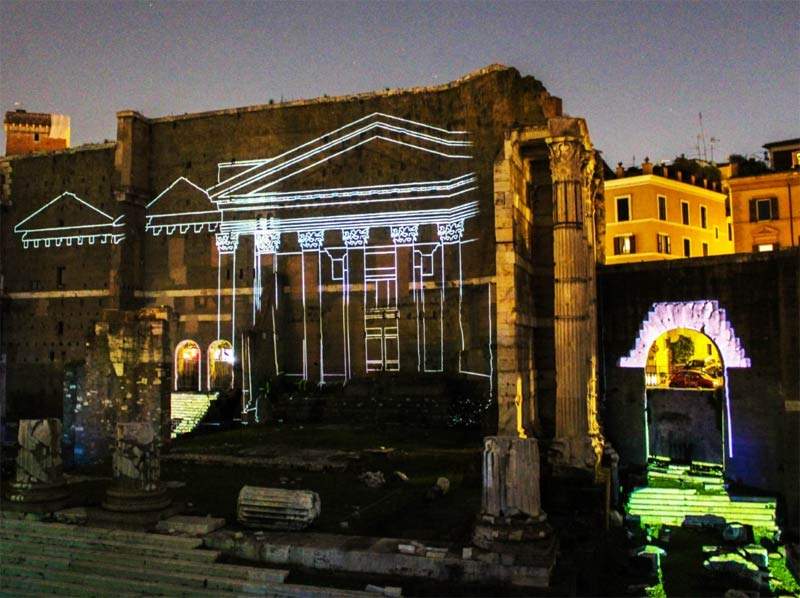From June 10 to October 2, after the success of past editions, the multimedia project Journeys in Ancient Rome, curated by Piero Angela and Paco Lanciano, returns to Rome, with shows available in eight languages that bring to life the history of the Forum of Augustus and the Forum of Caesar. The project is promoted by Roma Culture, Sovrintendenza Capitolina ai Beni Culturali and produced by Zètema Progetto Cultura, the conception is by Piero Angela and Paco Lanciano with the historic collaboration of Gaetano Capasso and with the Scientific Direction of the Sovrintendenza Capitolina.
Spectators will therefore be able to return to enjoy a performance that has always proved to be very engaging for the public and at the same time full of rigorous information, accompanied by the voice of Piero Angela and the vision of films and projections that reconstruct the two places as they appeared in ancient Rome. The two shows, which can be listened to by audiocuff, as anticipated, in eight languages (Italian, English, French, Russian, Spanish, German, Chinese and Japanese), have different modes of enjoyment and will take place in compliance with the current regulations on measures regarding the contrast and containment of the spread of Covid-19. For the “Forum of Augustus,” three replicas are scheduled each evening (duration 40 minutes), while for the “Forum of Caesar,” it can be accessed every 20 minutes (itinerant route in four stages, for a total duration of about 50 minutes, including travel time). Tickets can be pre-purchased online at www.viaggioneifori.it or directly on site and at Tourist Infopoints. For MIC card and Roma Pass holders, there is a reduced entrance fee.
The show at the Forum of Augustus is attended by sitting in stands set up along Via Alessandrina. Through a multi-projection of lights, images, films and animations, Piero Angela’s narrative focuses on the figure of Augustus, whose gigantic statue, a full 12 meters high, was kept next to the temple dedicated to Mars Ultor. With Augustus, Rome inaugurated a new period in its history: the imperial age was, in fact, that of the great rise, which, in the space of little more than a century, led Rome to reign over an empire stretching from present-day England to the borders of present-day Iraq, encompassing much of Europe, the Middle East and all of North Africa. These conquests led to the expansion not only of an empire but also of a great civilization made up of culture, legal rules, and art. In all parts of the empire even today traces of that past remain, with amphitheaters, baths, libraries, temples, roads.
After Augustus, moreover, other emperors such as Nerva and Trajan left their mark in the Imperial Forums by building their own Forum. Rome at that time had more than a million inhabitants-no city in the world had ever had a population of that size. It was the great metropolis of antiquity: the capital of economy, law, power and entertainment.
The show inside the Forum of Caesar is itinerant. It is accessed from the staircase located next to Trajan ’s Column and then crosses the Forum of Trajan on a specially made walkway. Through the underground tunnel of the Imperial Forums one then reaches the Forum of Caesar and thus continues to the Roman Curia.
Piero Angela’s narrative, accompanied by reconstructions and films, starts from the history of the excavations carried out between 1924 and 1932 for the construction of the then Via dell’Impero (today Via dei Fori Imperiali), when an army of 1,500 masons, laborers and workers was mobilized for an unprecedented operation: razing an entire neighborhood to the ground and digging deep into the entire area to reach the level of ancient Rome. Then we get into the heart of history starting with the remains of the majestic Temple of Venus, built by Julius Caesar after his victory over Pompey, and we can travel through the life of the time in Rome, when officials, plebeians, soldiers, matrons, consuls and senators strolled under the porticoes of the Forum. In fact, among the remaining colonnades reappear the tabernacles of the time, that is, the offices and stores of the Forum and, among them, the store of a nummulary, a kind of exchange office of the time. At that time there was also a large public toilet of which curious remains have remained. To build his Forum, Julius Caesar had an entire neighborhood expropriated and demolished at a total expense of 100 million aurei, the equivalent of at least 300 million euros. Next to the Forum he had the Curia, the new seat of the Roman Senate, built, a building that still stands today and which through a virtual reconstruction can be reviewed as it appeared at the time.
In those years, while Rome’s power was growing by leaps and bounds, the Senate was greatly weakened, and it was in this situation of internal crisis that Caesar was able to obtain exceptional and perpetual powers. Thanks to Piero Angela’s account, therefore, we will be able to learn more about this intelligent and ambitious man, idolized by some, hated and feared by others.
Image: forum of Augustus
 |
| Travels to ancient Rome returns with Piero Angela and Paco Lanciano |
Warning: the translation into English of the original Italian article was created using automatic tools. We undertake to review all articles, but we do not guarantee the total absence of inaccuracies in the translation due to the program. You can find the original by clicking on the ITA button. If you find any mistake,please contact us.